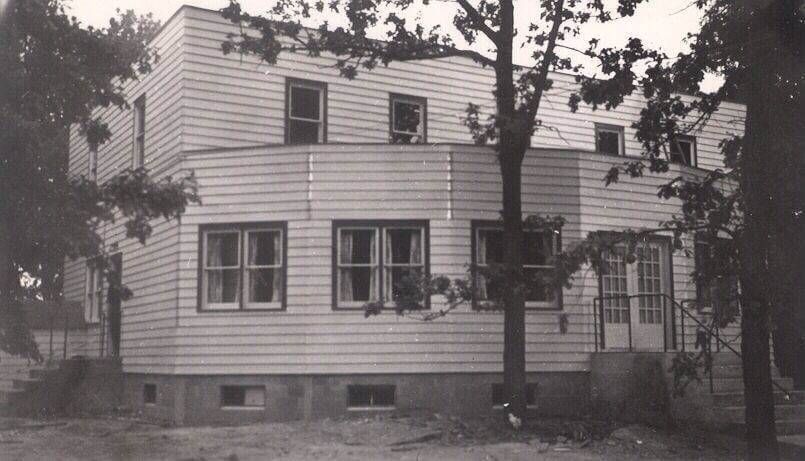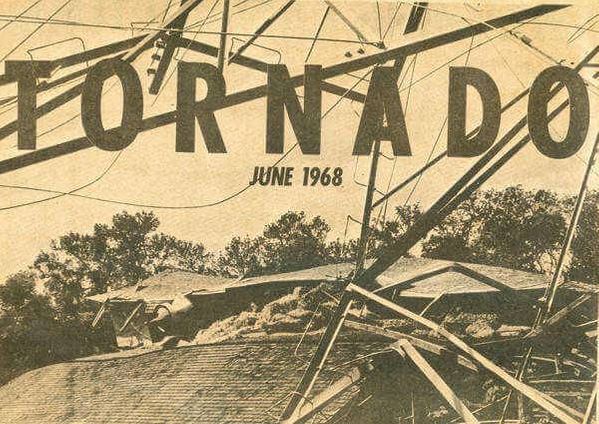12 Experiences, Sightings & Near Misses of Tornadoes
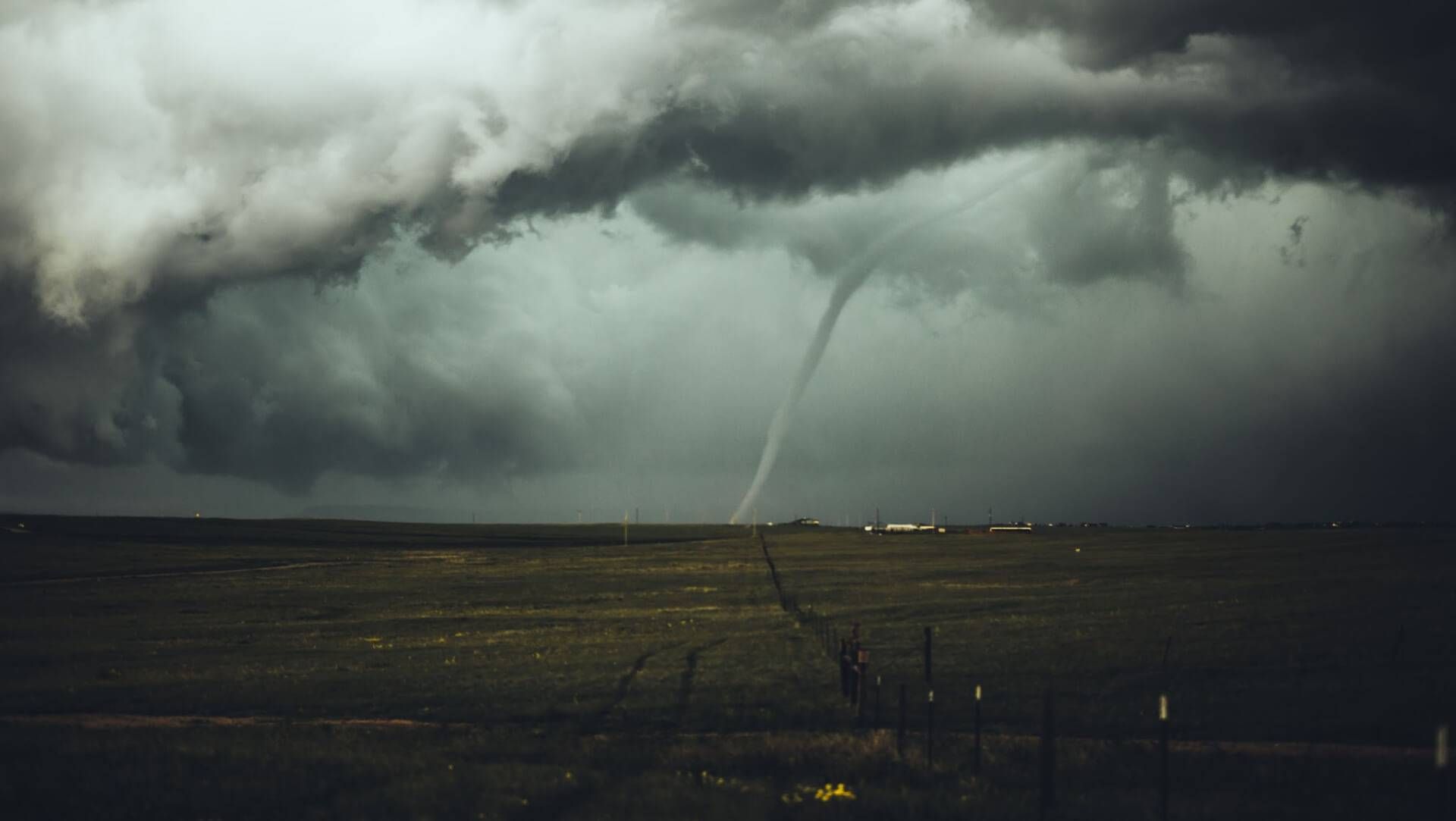
Live in Minnesota long enough and you're bound to experience the sudden, slightly green-hued darkening of the sky coupled with a burst of wind that seems to swell up from deep underground. Sometimes these moments of intense weather feature pelting hail. Sometimes it barely rains at all, despite displays of thunder and lightning.
And sometimes, you look in the distance and witness a whirling cloud that seems to connect ground and sky like an artery of dust and debris. A funnel cloud. A twister. A tornado. A startling thing of destruction.
Minnesota may ride the northern edge of Tornado Alley, but some of the most powerful touchdowns have picked up train cars like toys and turned wisps of hay into missiles that become embedded in tree trunks. The most deadly tornado in state history occurred on April 14, 1886, and as it ripped through the St. Cloud and Sauk Rapids townships, 11 people in a wedding party were killed, including the groom. Rest assured, the bride apparently remarried. One of the costliest tornado outbreaks unfolded on May 6, 1965, when six funnel clouds touched down in six different Twin Cities counties, causing $51 million in damage.
Since tornados figure prominently in the biography of the state, we asked Twin Cities PBS staffers to share their experiences of cyclones. After all, there are arguably two types of Minnesotans: those who take shelter when the sirens go off, and those who wait to capture footage for posterity.
The third kind of Minnesotan
I think there's a third kind of Minnesotan - the ones who first seek shelter and then take photos. I have a bunch of slides from the June 1981 tornado that ripped through Minneapolis and ended up in Roseville (thus starting the "tornado madness" sale at Sound of Music, which later became Best Buy). We lived in the Phillips neighborhood of Minneapolis at the time, and my husband took a ton of "tornado devastation" photos, including some cool shots of the parking lot at Sears on Lake Street.
My husband and I had just put our toddler daughter to bed for a nap when we heard what sounded like a freight train outside our window. The box fan in our living room window flew across the room, and we picked up our daughter and went to the basement. After a while, things got quiet. When we came back upstairs, we found that all the windows in our first-floor duplex were shattered. We swept up the glass; then my husband went out and took the photos you will soon see. Several of our neighbors used his photos to document their insurance claims. - Beth Daniels, STEM Content & Education Manager; Photos by Martin Daniels
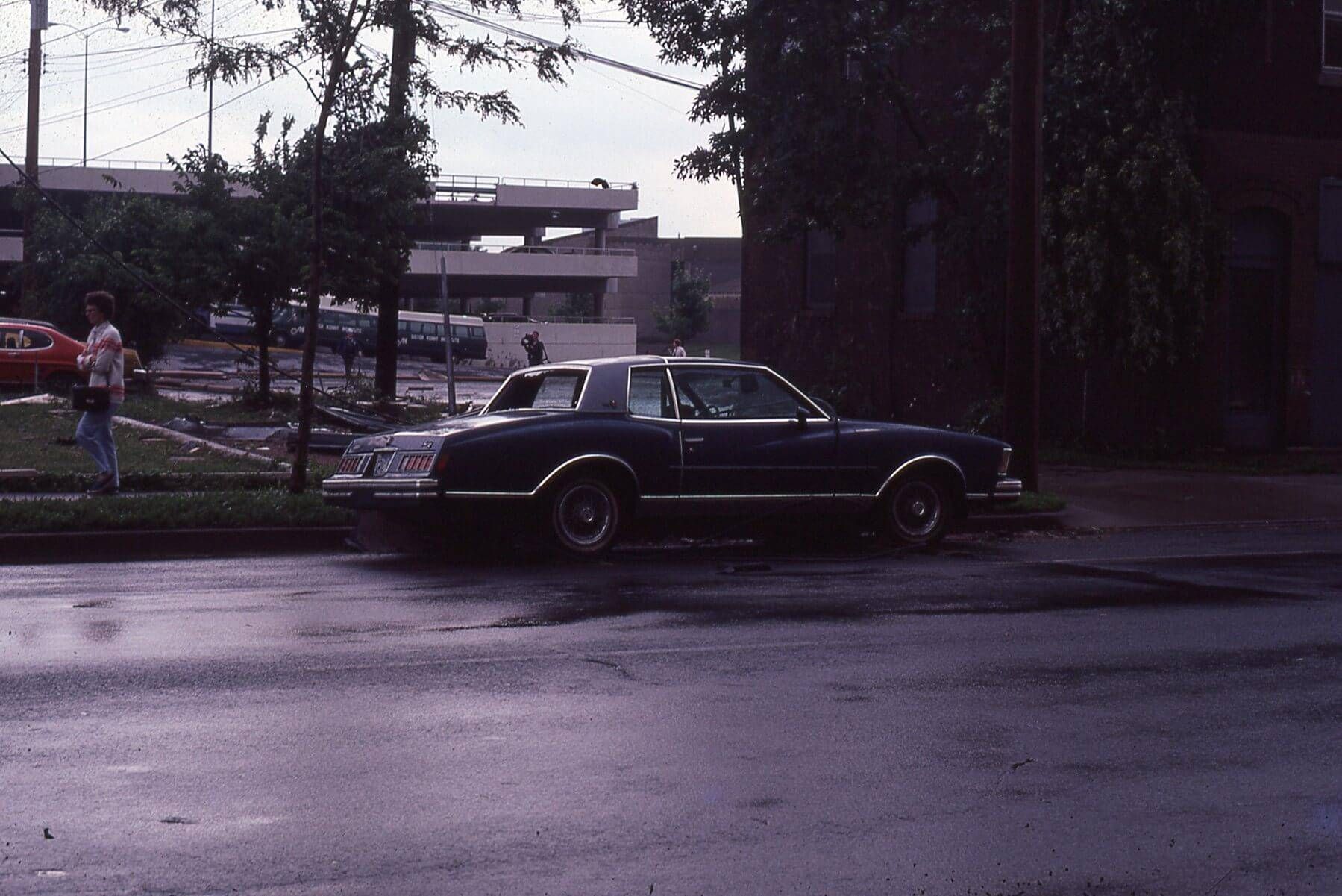
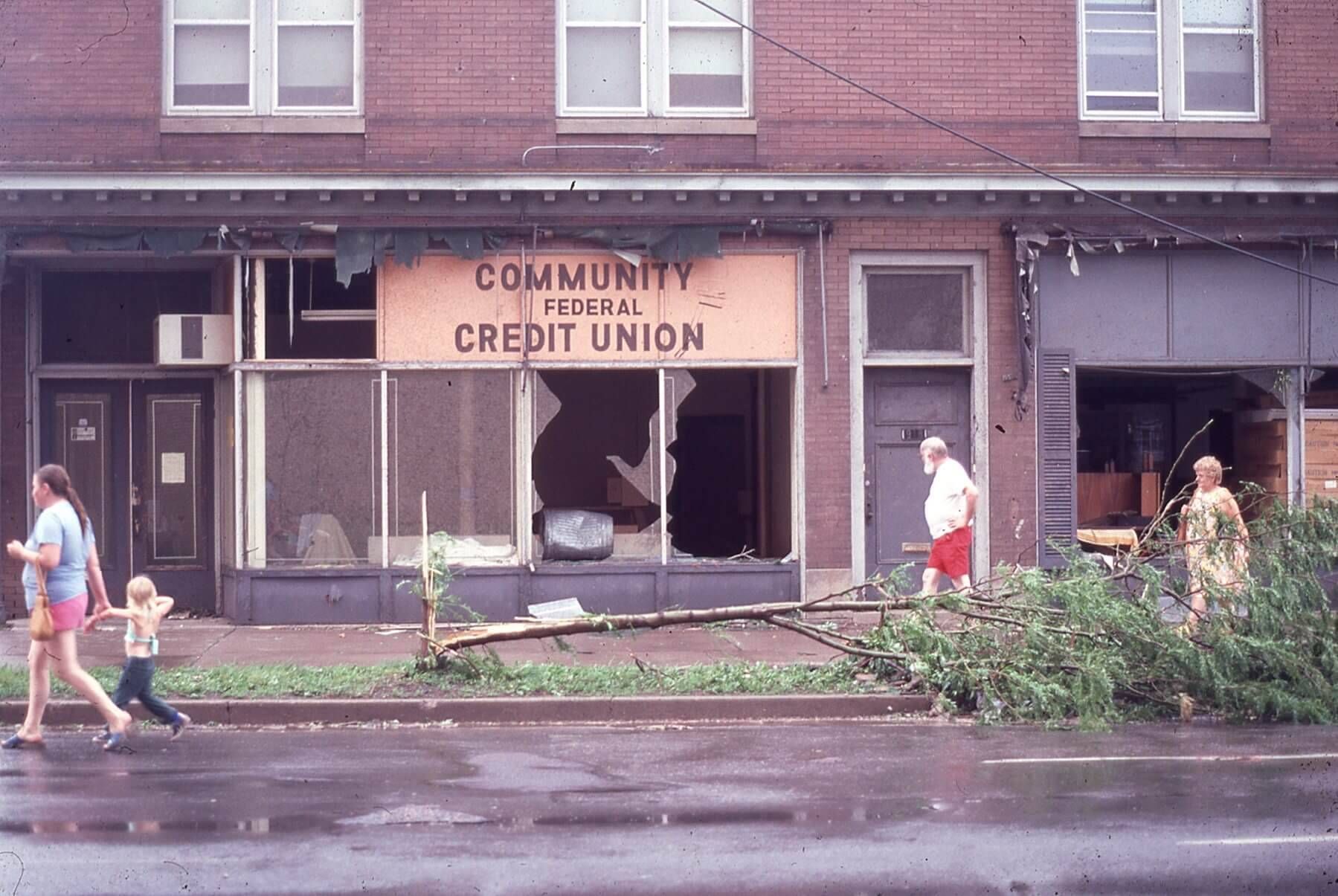

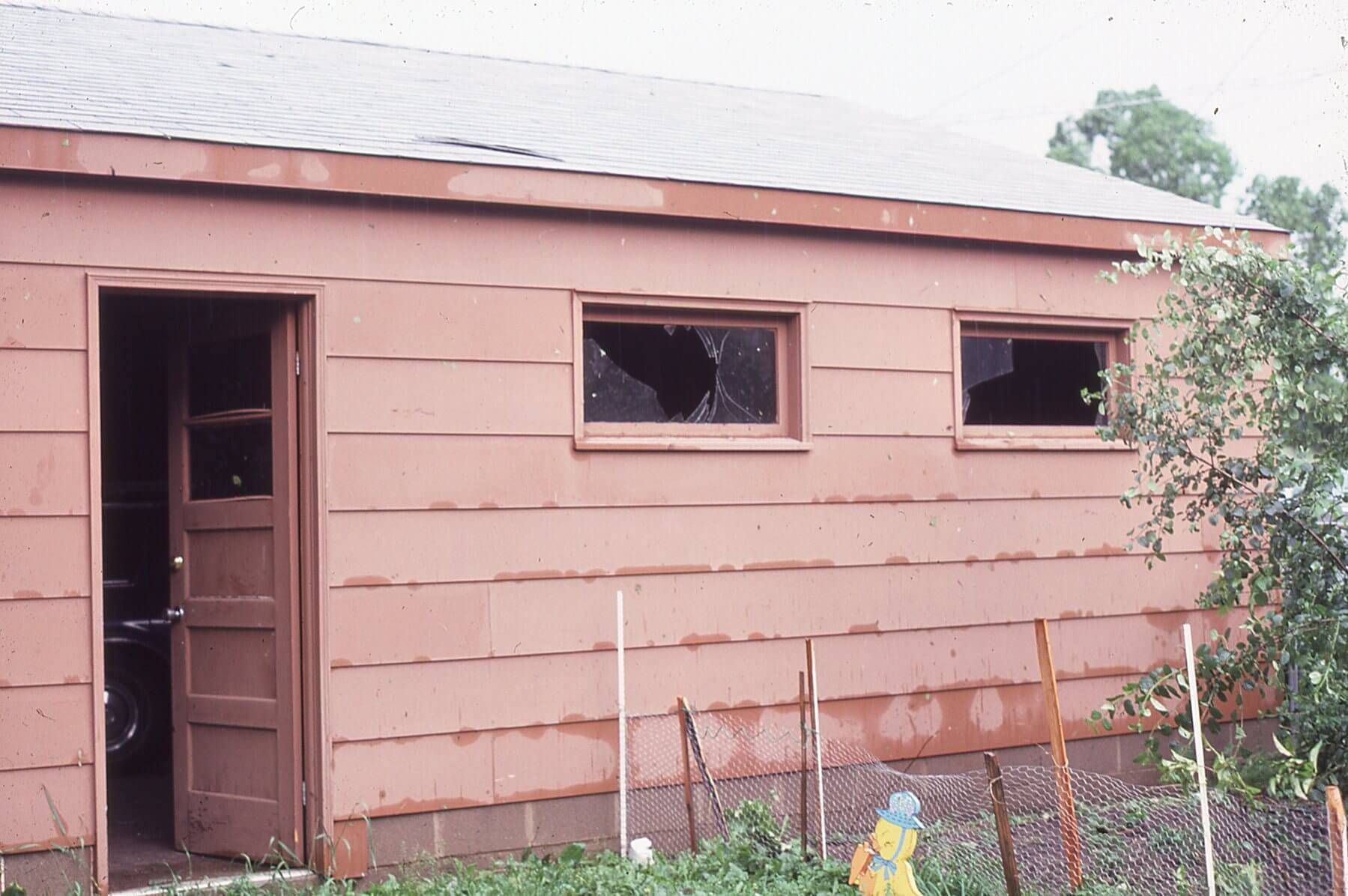
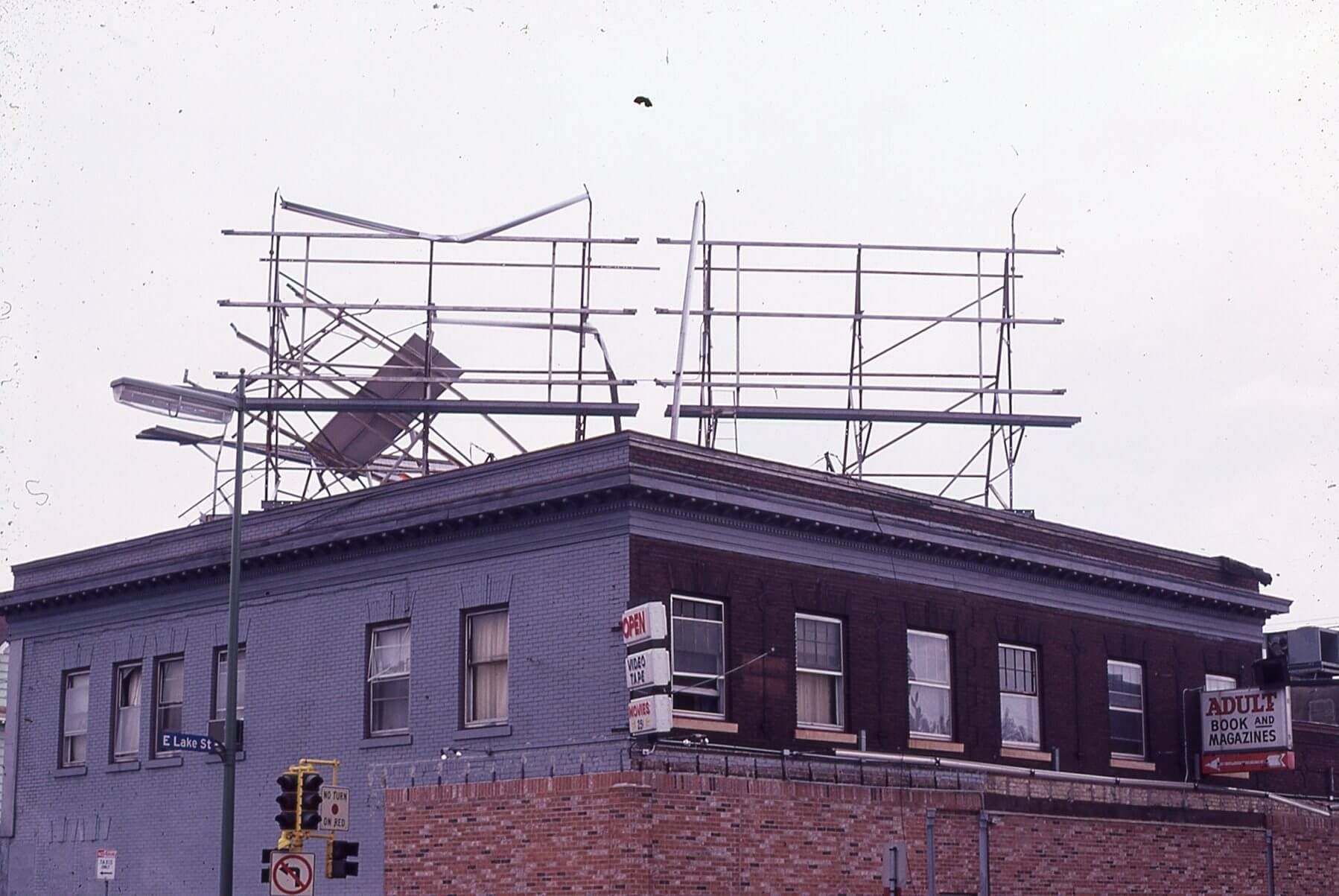
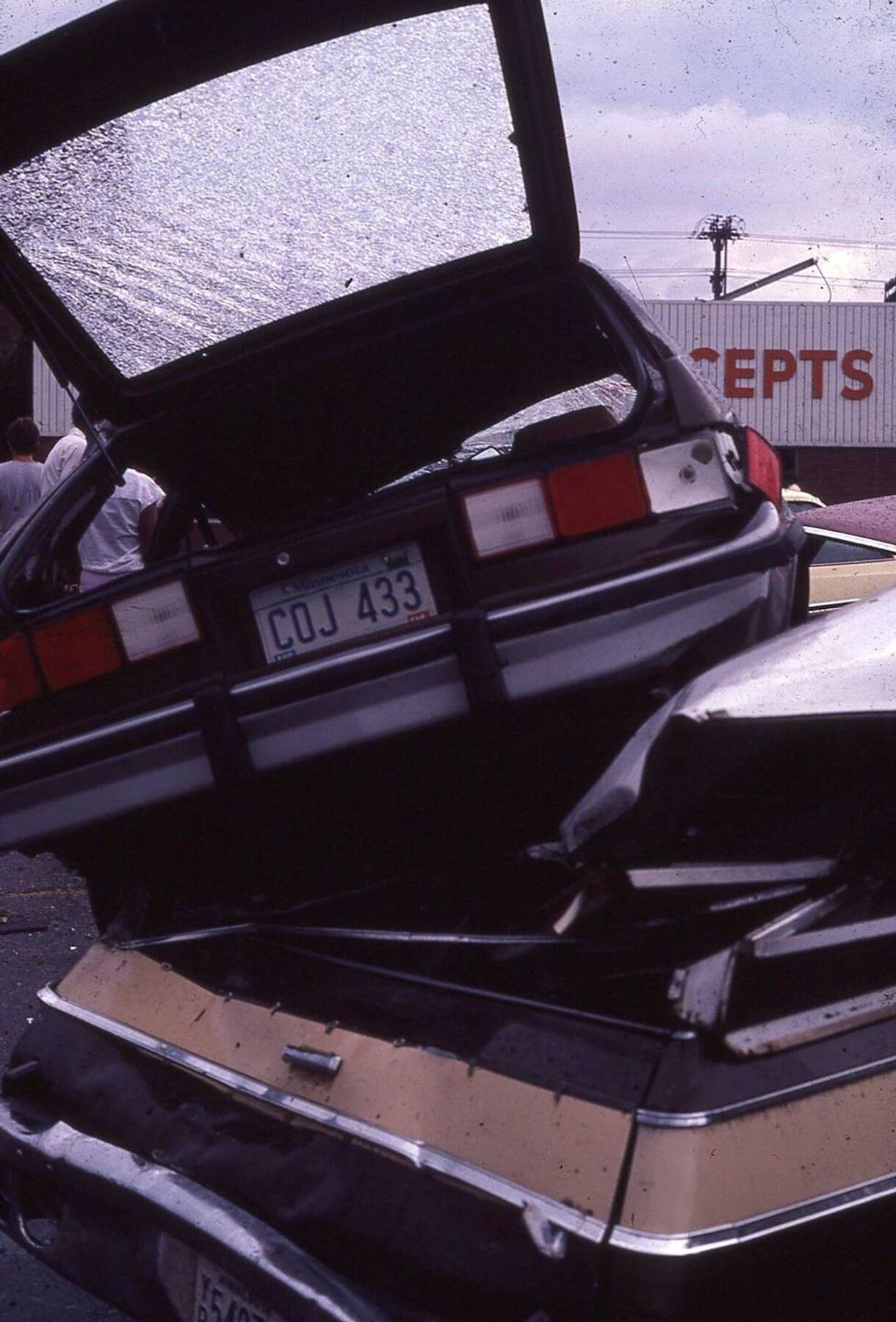
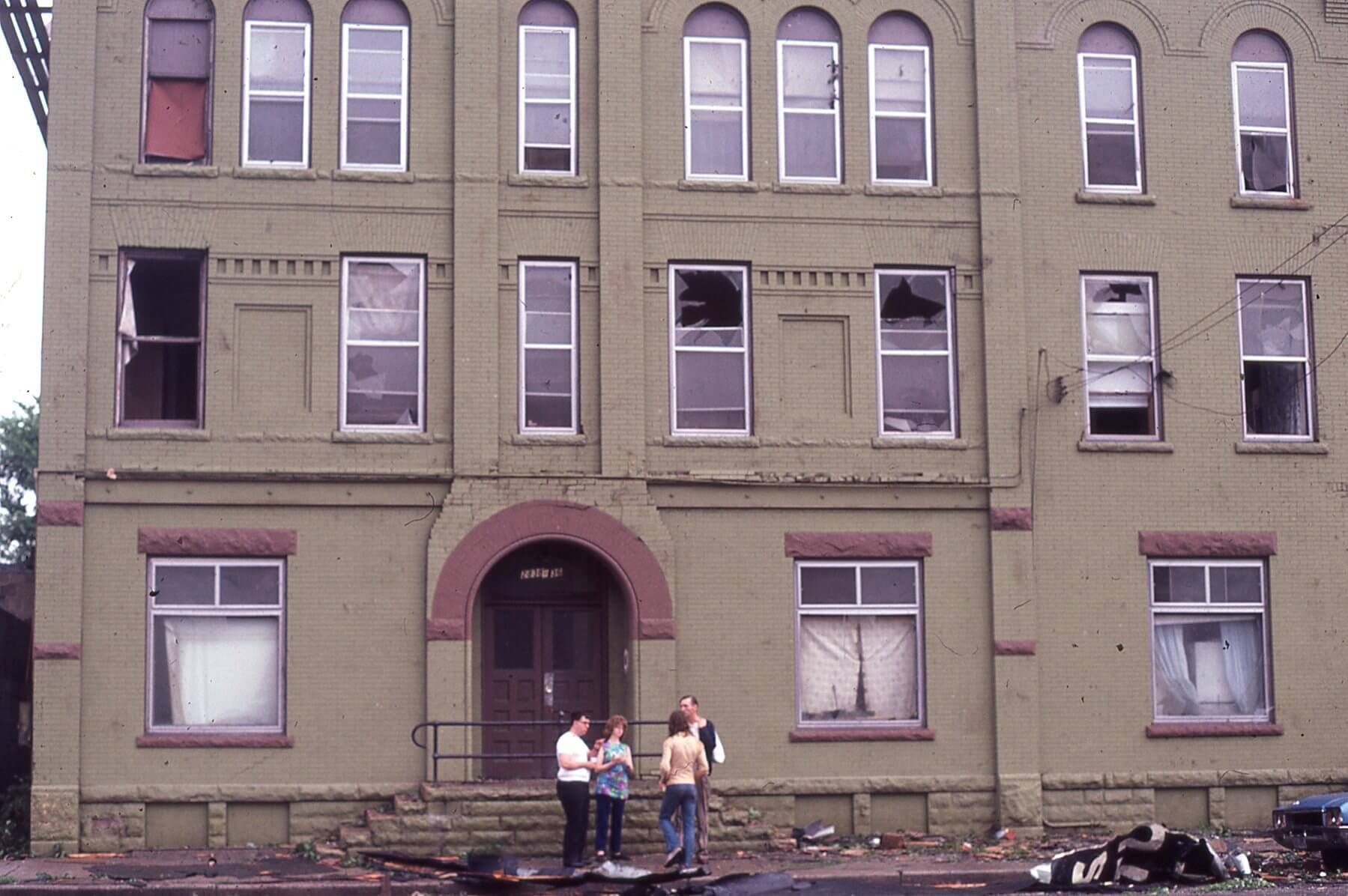
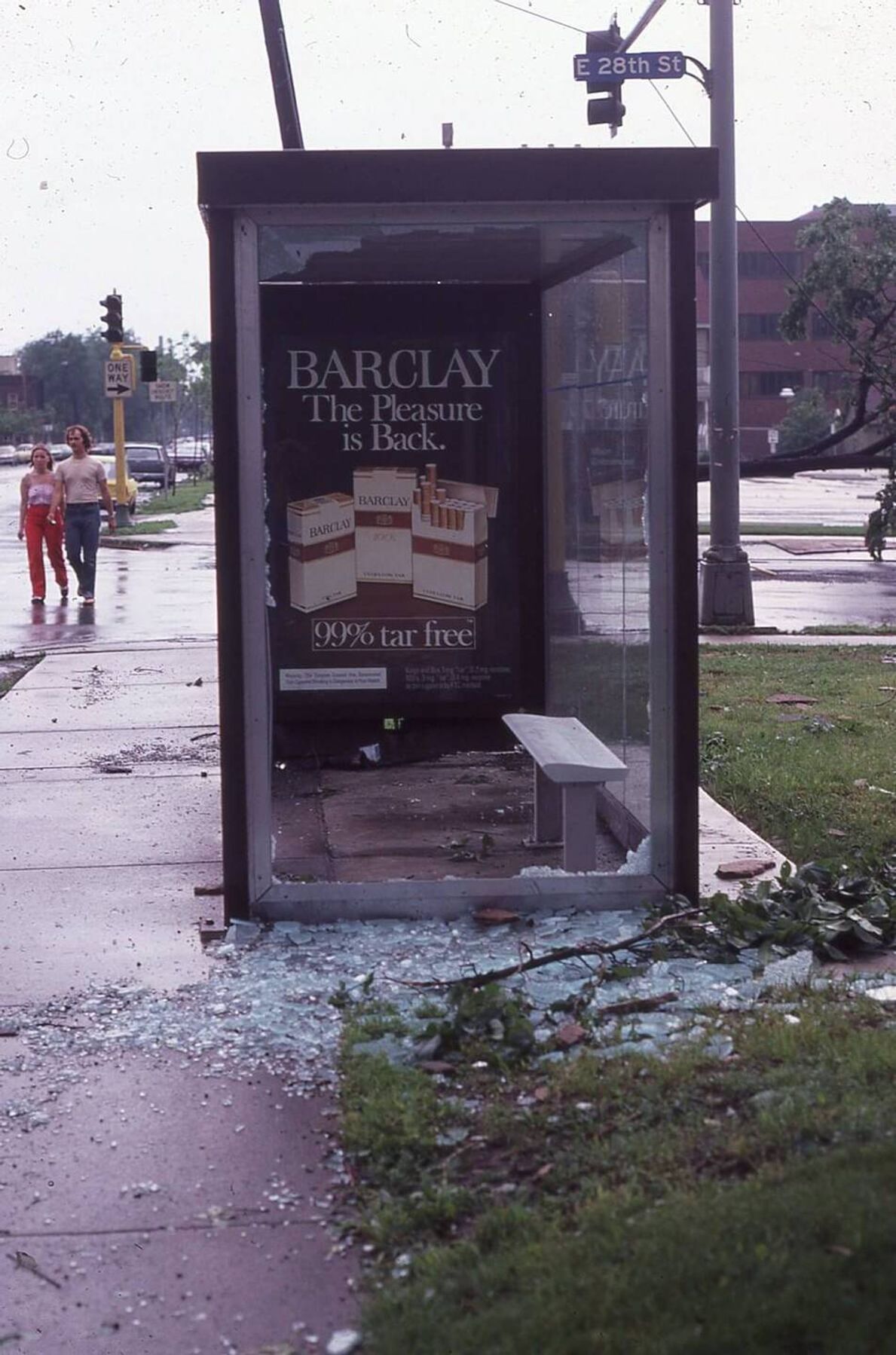
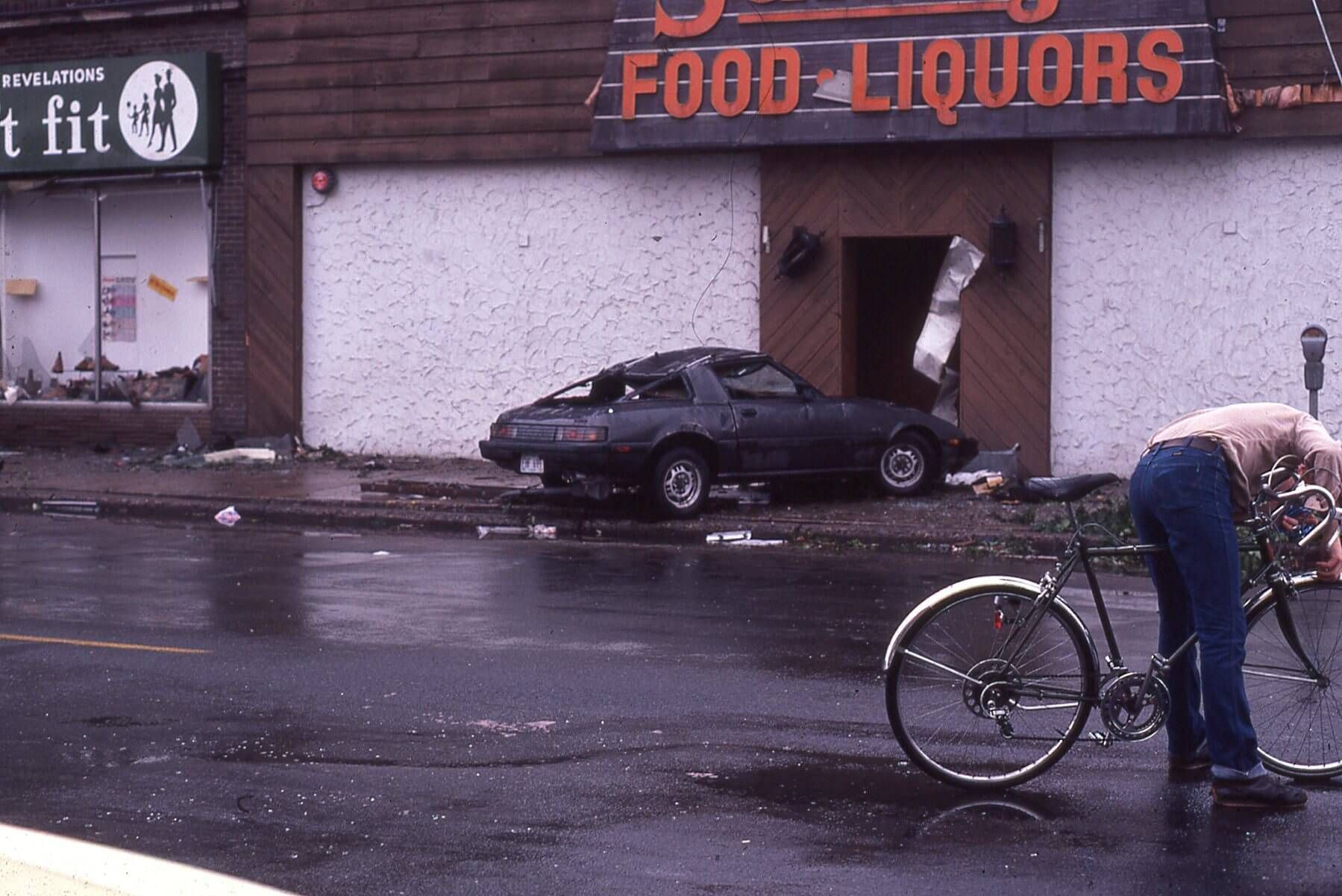
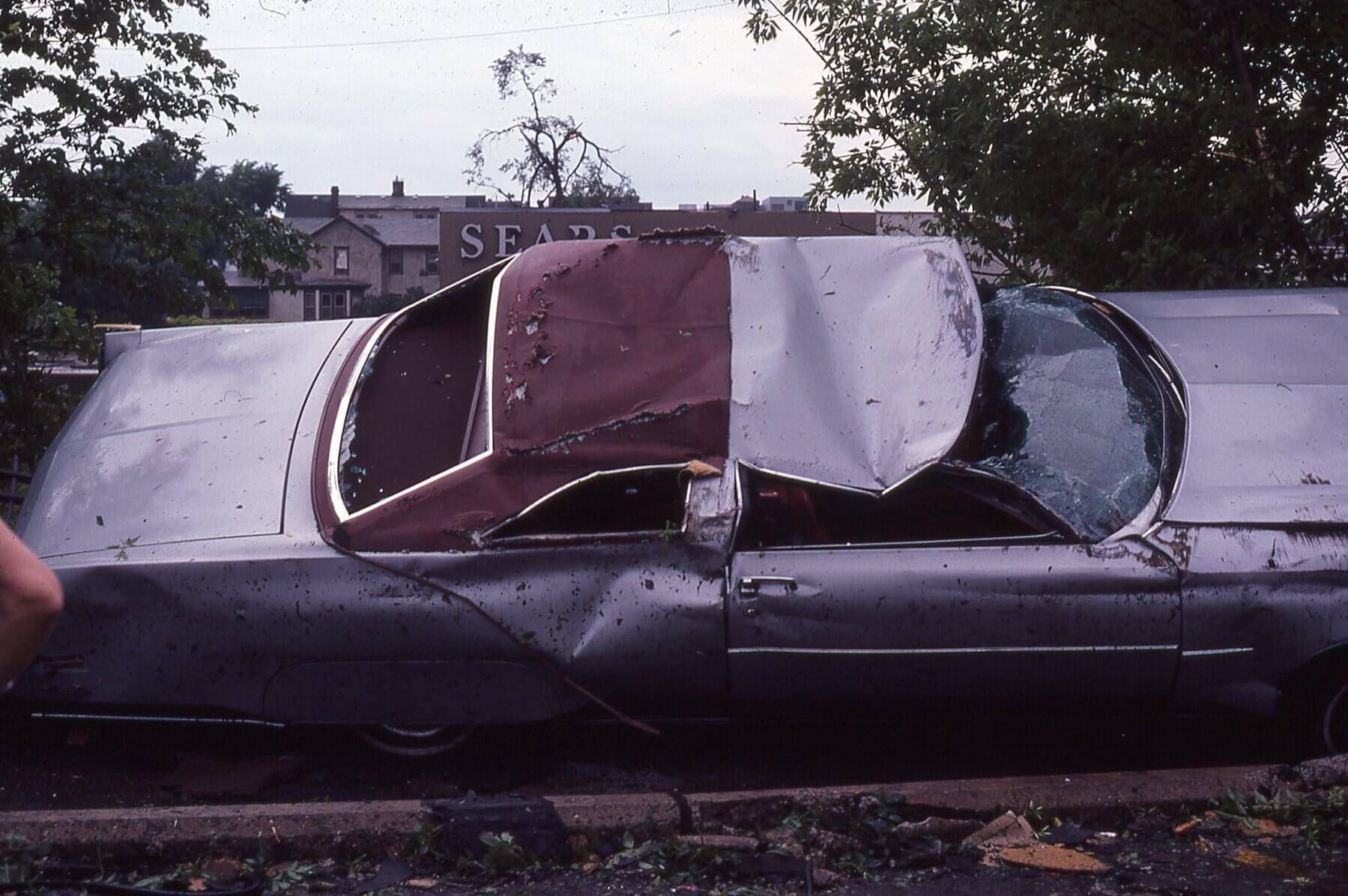
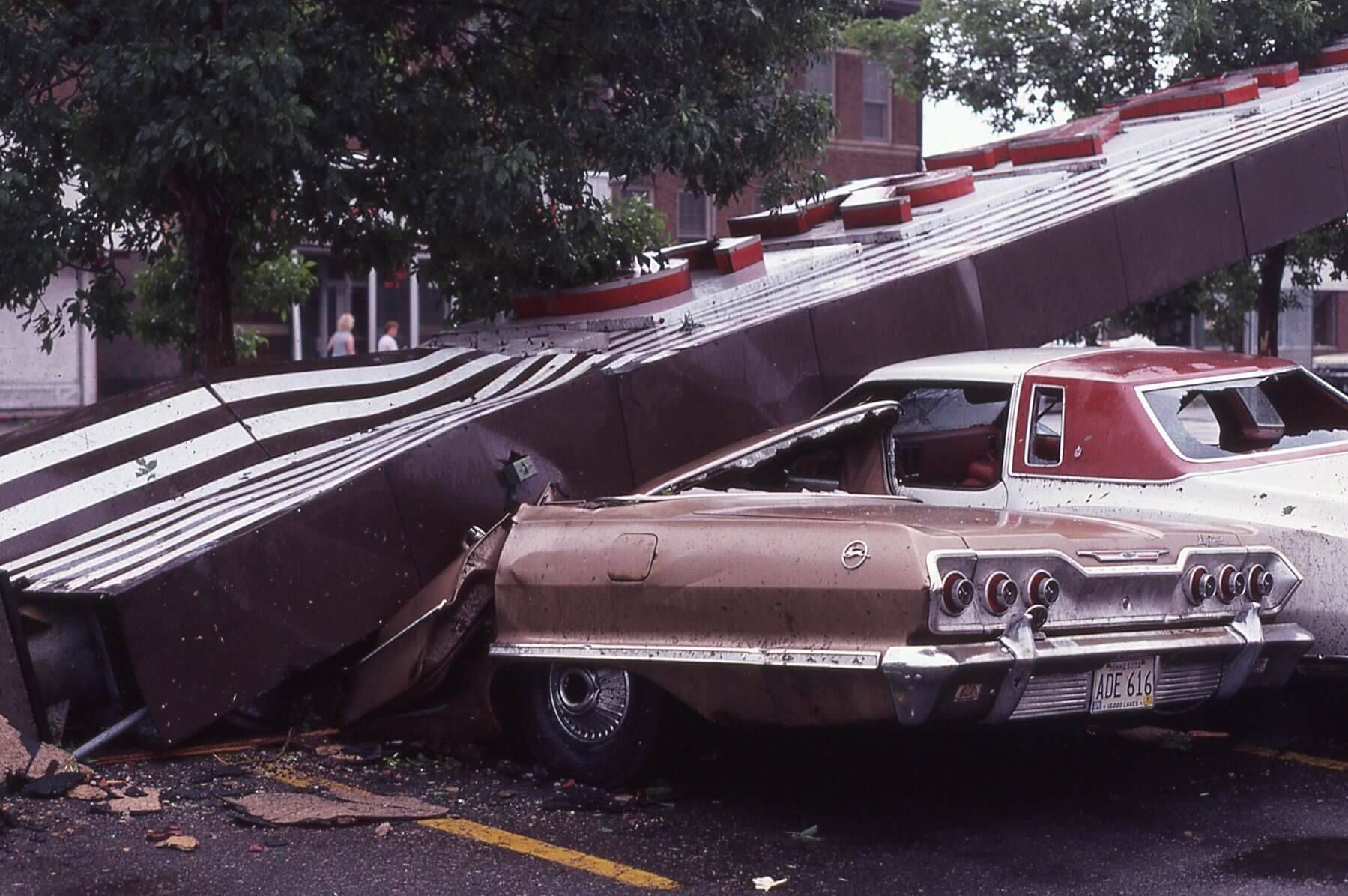
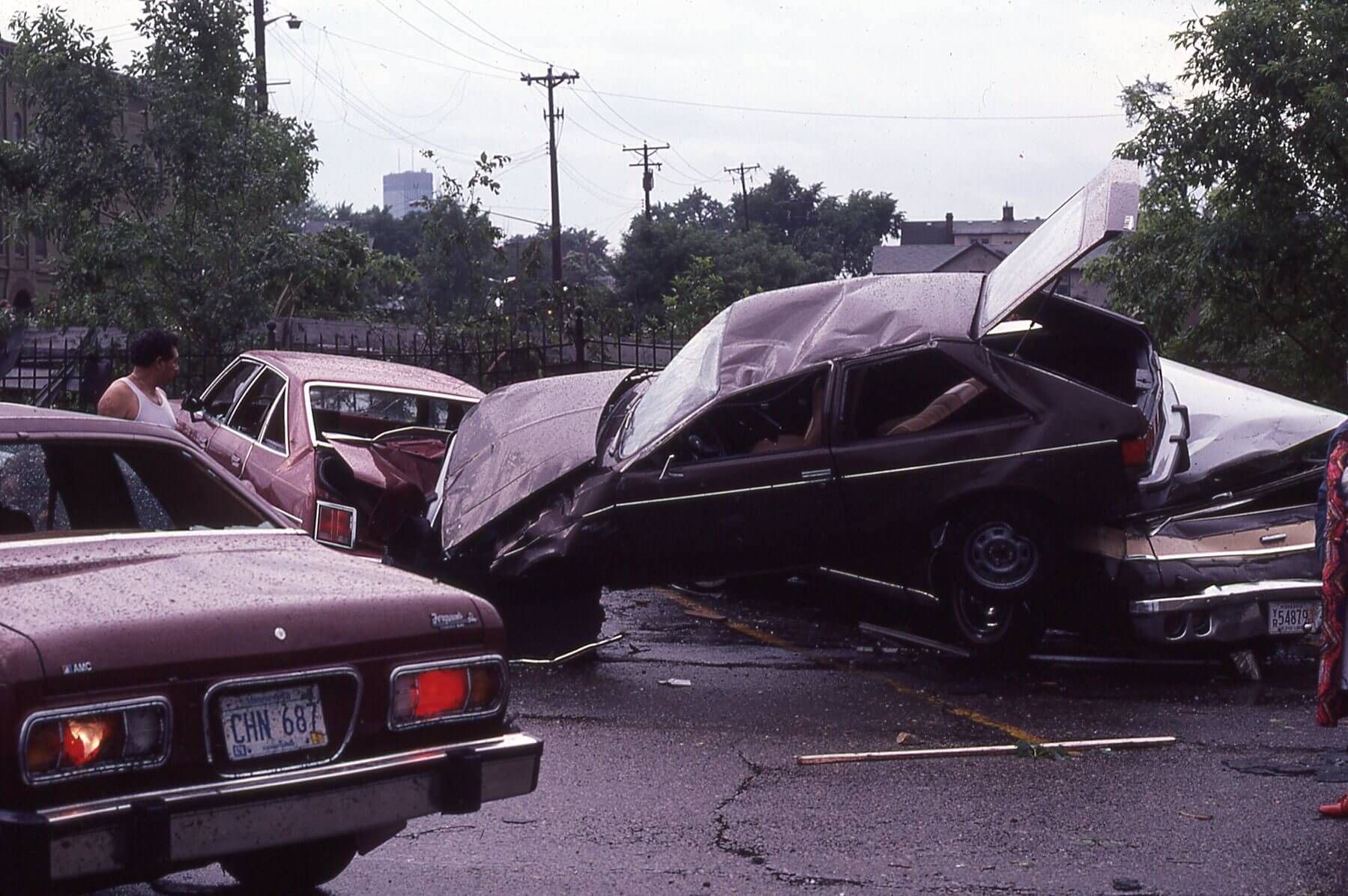
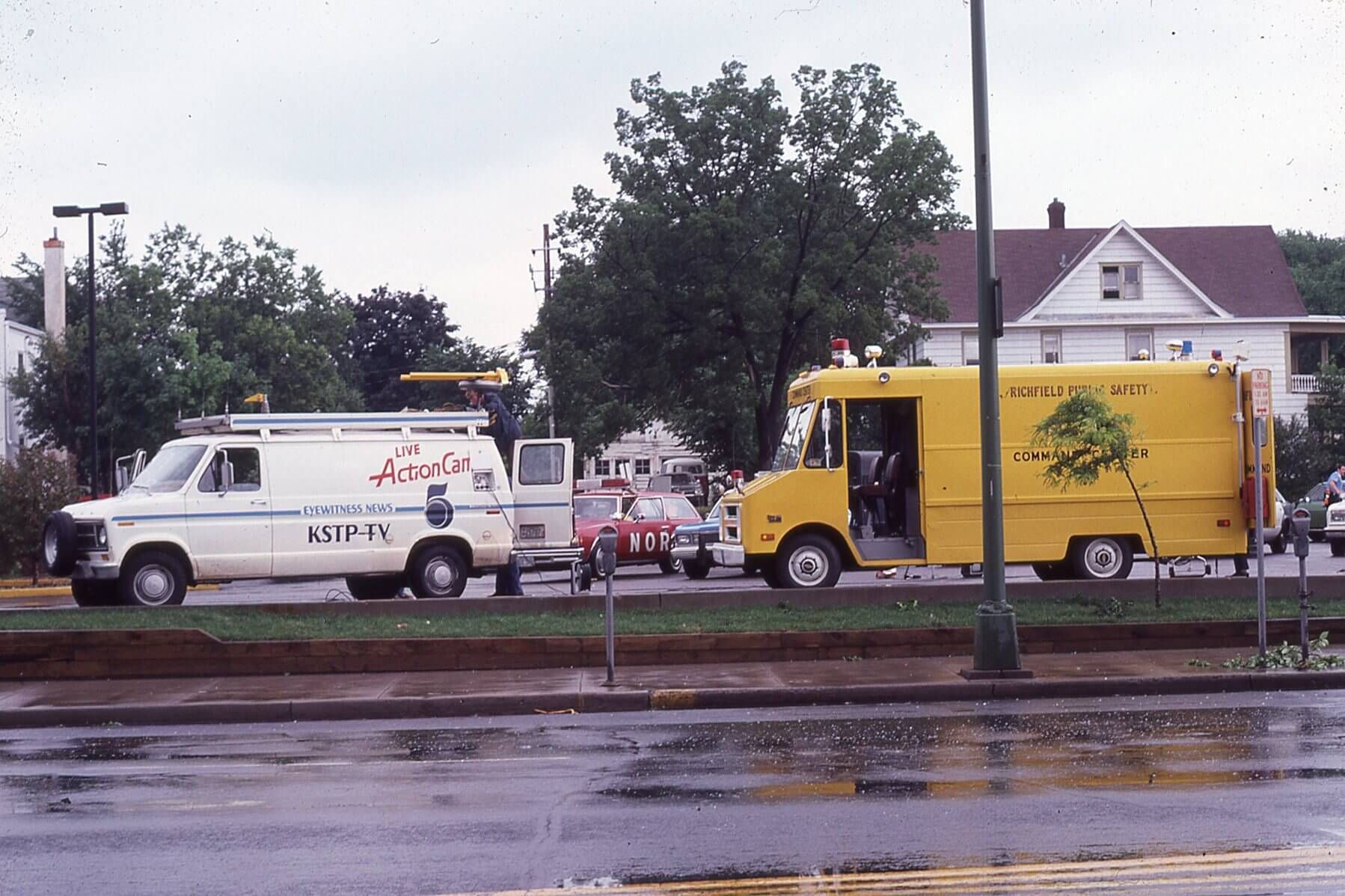
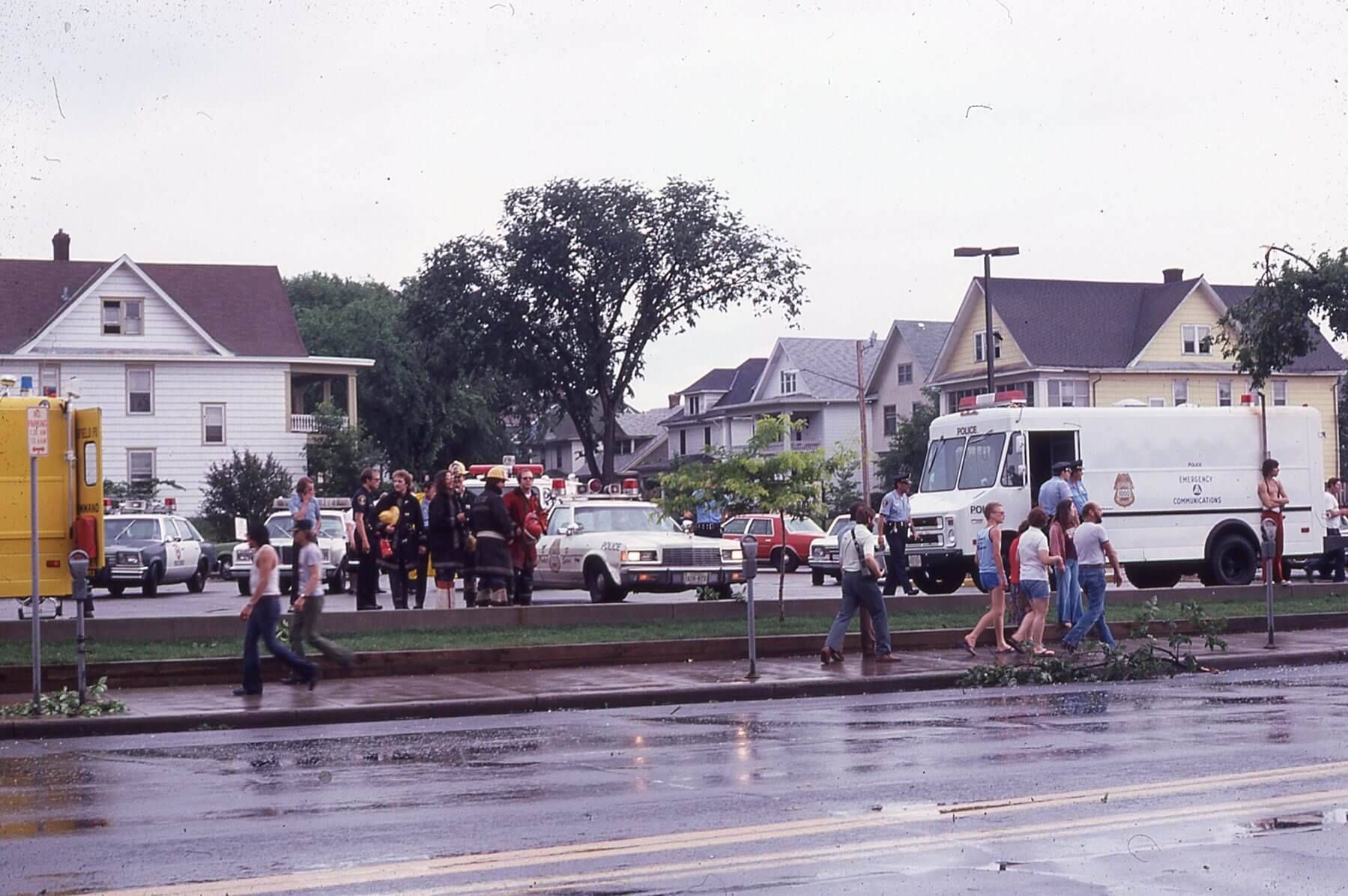
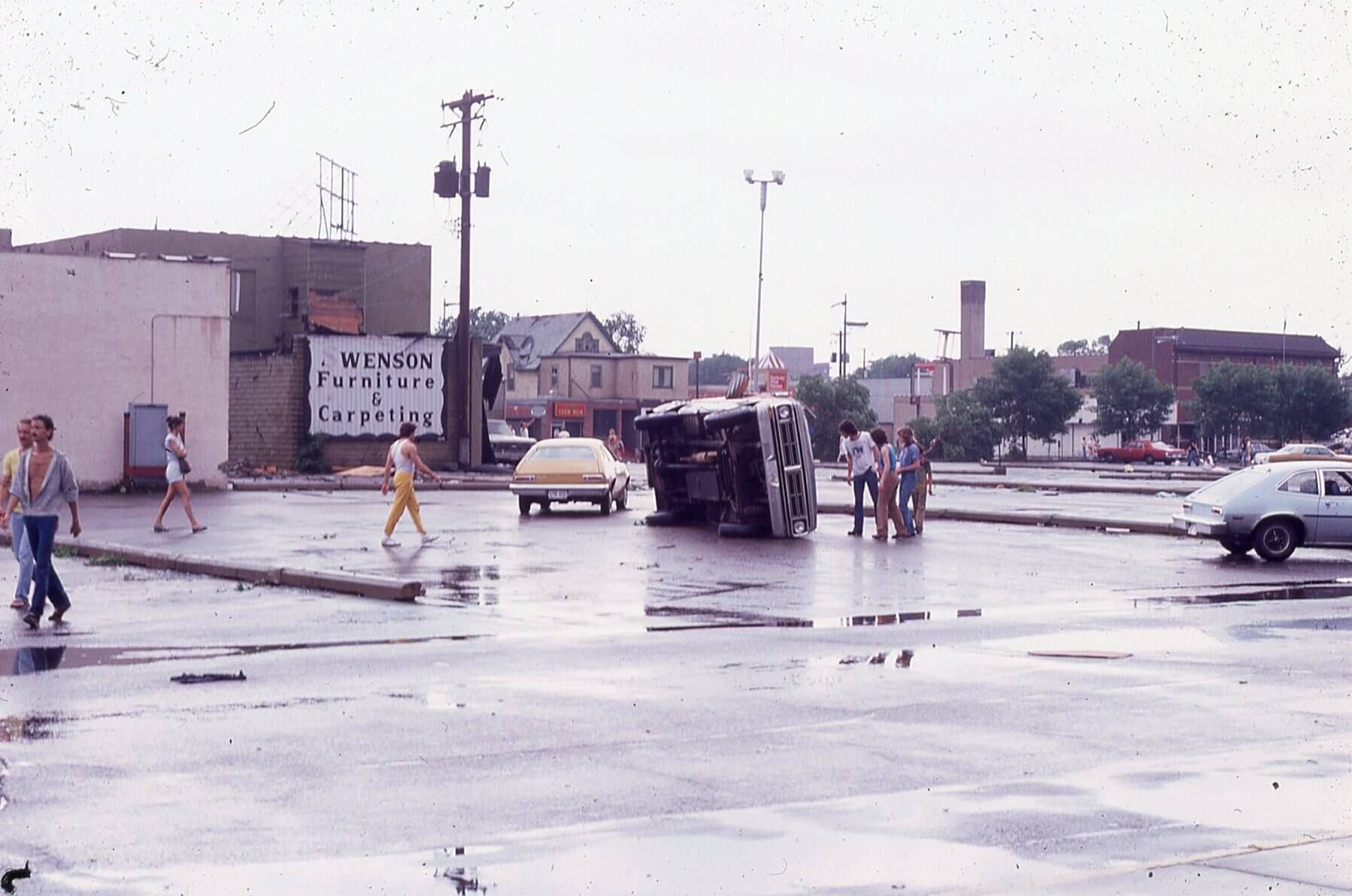
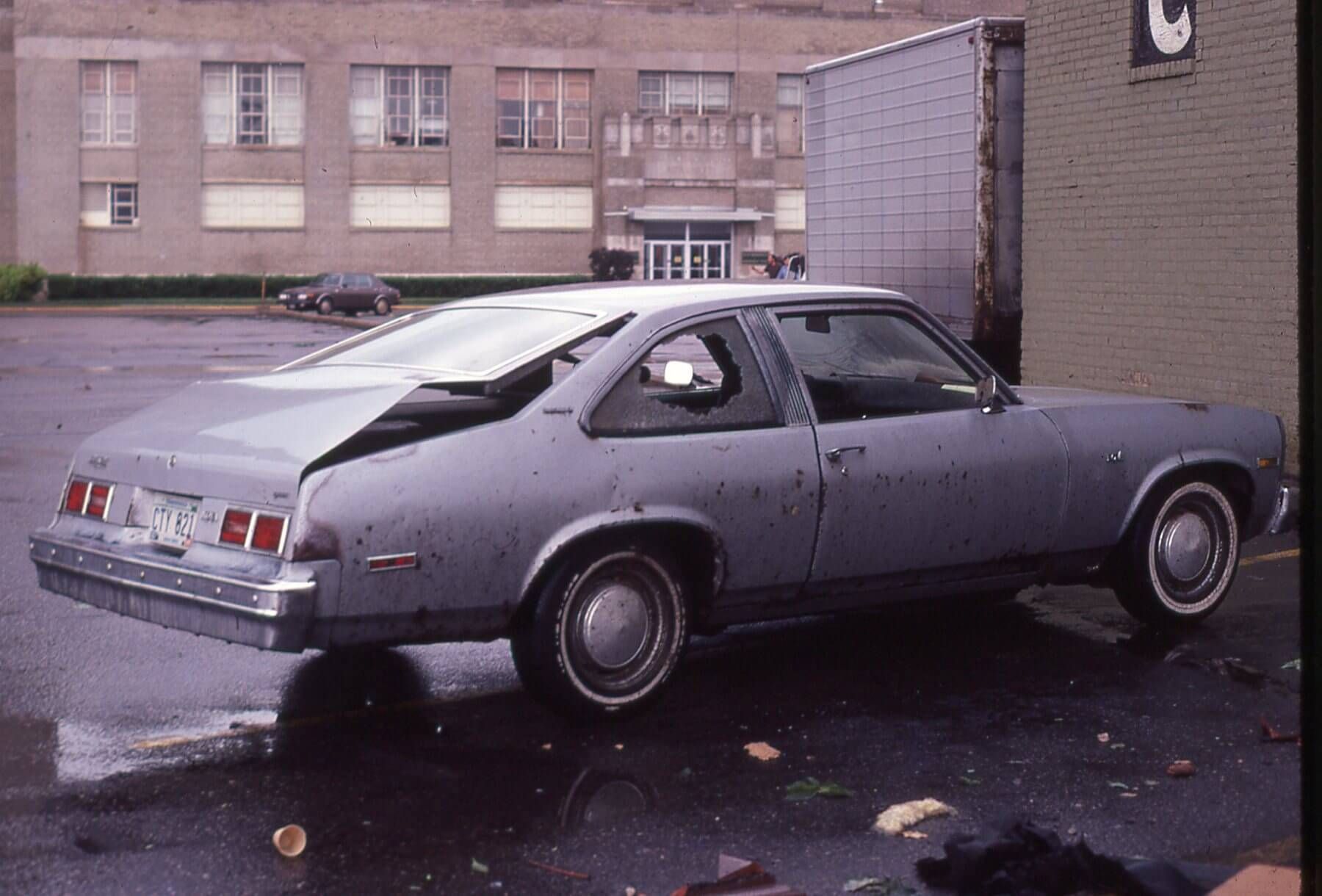
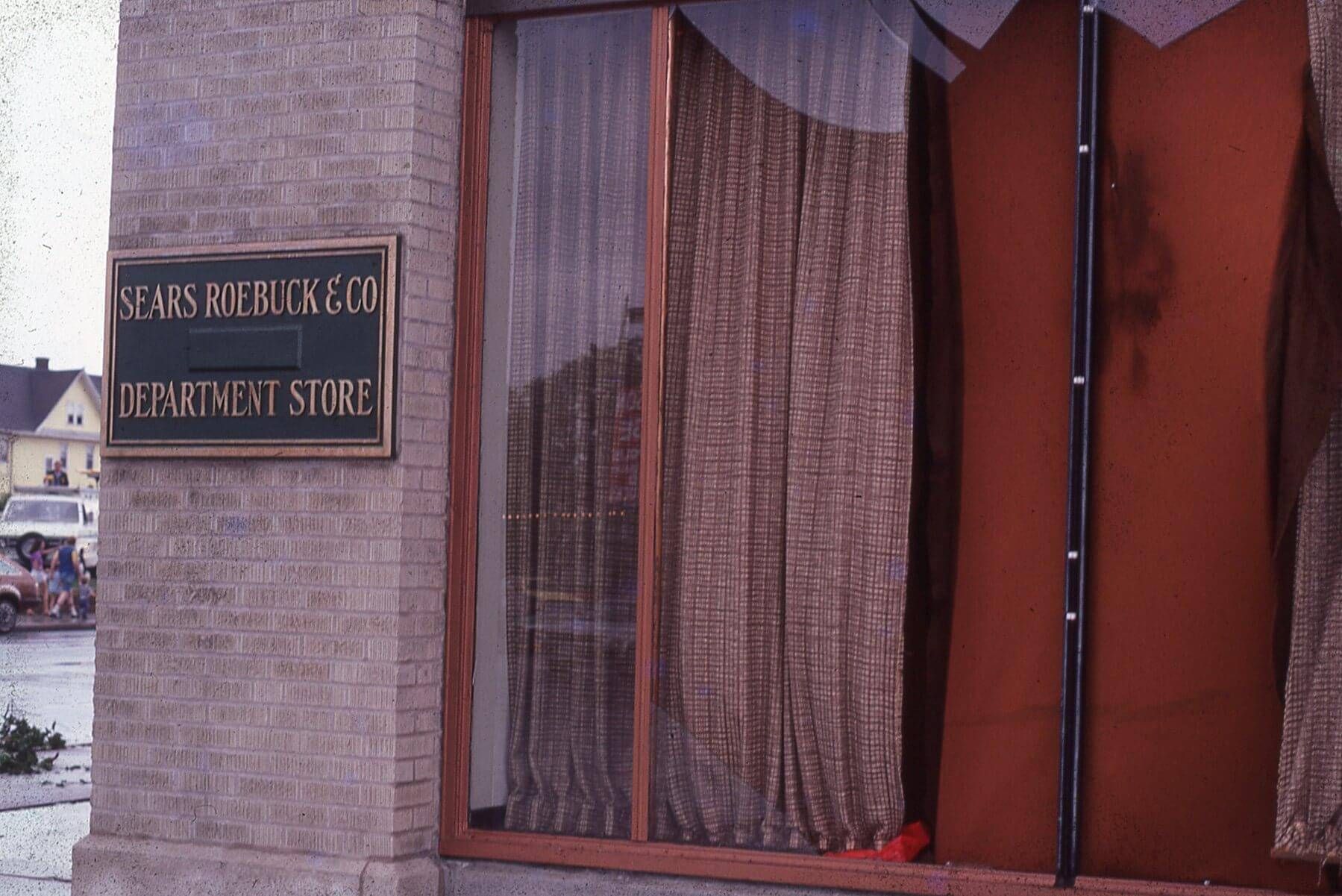
So you think it's a sunny day...
I was in Bismarck, North Dakota heading out to lunch when I heard sirens. Before me was a clear, blue sky as far as I could see. Turning around, I saw dark clouds over the bluffs south of town, with a tornado clearly visible. But I went out to lunch! And kept an eye on the sky, in ALL directions. And then in the future, I was less trusting of a nice-looking day, and more trusting of the National Weather Service! - Bruce Jacobs, Senior Director of Technology
A matter of blocks
When I was a young child, an F3 tornado went right through the metro, including my St. Anthony Park neighborhood in Saint Paul. We huddled in the basement for what felt like forever. When the storm cleared, we walked just blocks from our house to see massive destruction. It was very scary and cemented in my young mind that tornadoes are to be taken very seriously. I remember seeing t-shirts later that said something to the effect of "I Survived the St. Anthony Park Tornado of 1981". - Kevin Dragseth, Producer
Learn all about the destruction of that 1981 Twin Towns tornado that also rained baseball-sized hail on the Lake Minnetonka area in this Hennepin County debrief.
The tornado that changed everything
The year was 1911. The Trager family of German immigrants were living on a farm outside Appleton, Minnesota. Margaret Trager was four years old, and remembers her older sister, Elsie, taking her in to another room and playing the music box to try to distract her from the horrible sound of a storm coming. She would remember it for the rest of her life. She remembers the house "whirling up into the air" with her inside. She woke up and saw the most beautiful sky she had ever seen. Next to her was her sister, Elsie; they were holding hands "like they were laying in bed together." Elsie would then take her last breath and die. Margaret's mother would also be found dead in the debris of the storm. Margaret had many injuries, but somehow survived and thrived and went on to lead a long, full life, inspiring generations to come. - Mary Lahammer, Anchor/Reporter/Producer
The story of Mary Lahammer's grandmother, Margaret, is woven into her documentary, Minnesota's Deadliest Tornadoes.
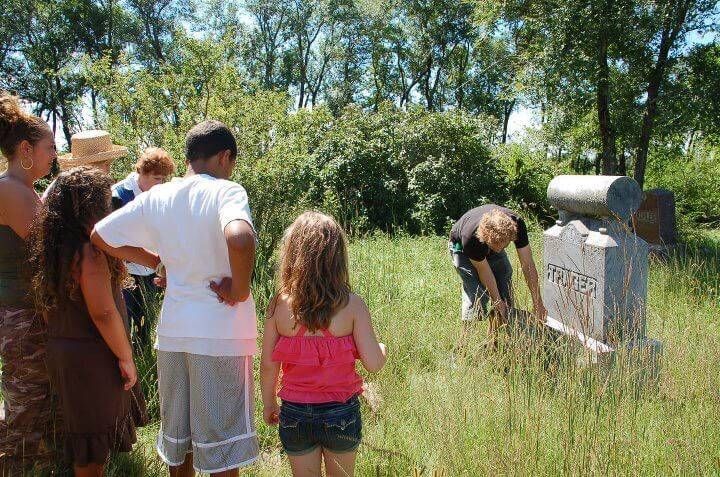
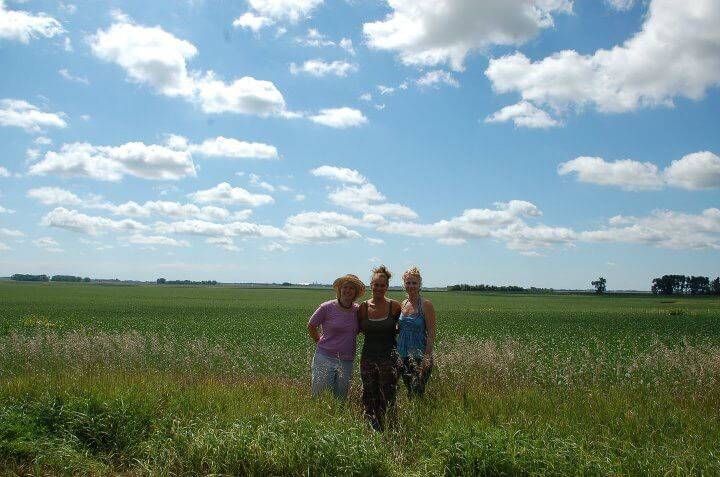

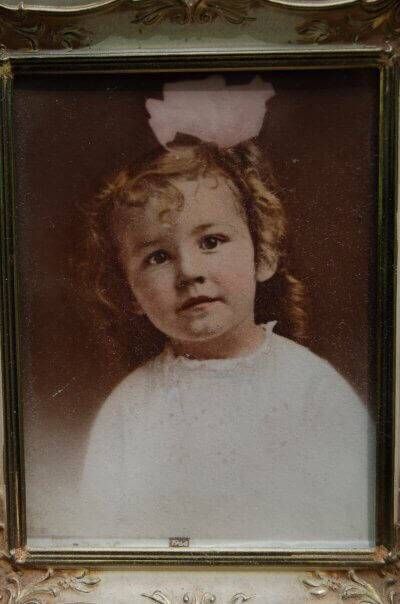
"In another life, I would have been a storm chaser."
We had a tornado go directly through my neighborhood in 1984 (I was 13). However, in my experience, my mom called me and told me to get into the basement because I was across town babysitting. [The tornado] destroyed a path of one or two houses four houses down the street from me, but nothing major in the rest of the neighborhood. We had a 2x4 go through the back window of our car, but it only damaged the window. The sirens went off about five minutes after my mom called me.
It was weird, though. One house looked fine, but it had been twisted six inches off its foundation, so it had destroyed the pipes and electrical wiring and everything else inside the walls. One house was shoved 10 feet straight back on the foundation. Trees were down everywhere, so I had to go through a police barricade to get back to my house the next morning. (I had been babysitting at my cousin's house, so I just stayed there.)
I was also in Albert Lea for the series of tornadoes that hit in June 2010, but all I saw were the clouds above my friend's house spinning wide. I knew it was a tornado forming, but I can't remember if the sirens had gone off yet. Kim made me get out of the front yard and go to the basement because she didn't want her kids getting ideas. It did a LOT of damage to the area about four to five miles from my friend's house, but I left for work at camp up in Itaska the next day, so I didn't actually see any of it.
Tornados are weird. They destroy one house, and yet the house next door can have NO damage - even have the hanging plant still attached to the garage like nothing was there. They fascinate me, and in another life I would have loved to be a storm chaser.
(In a related comment, when I started teaching in New York City, I asked if there was a tornado or snow storm plan for the school. They laughed at me and said tornadoes don't come to NYC and school is NEVER canceled for snow. That year, there was a tornado a couple of miles from my apartment in Brooklyn, and school was canceled 2 days for snow.) - Jennifer O'Byrne, Event Specialist
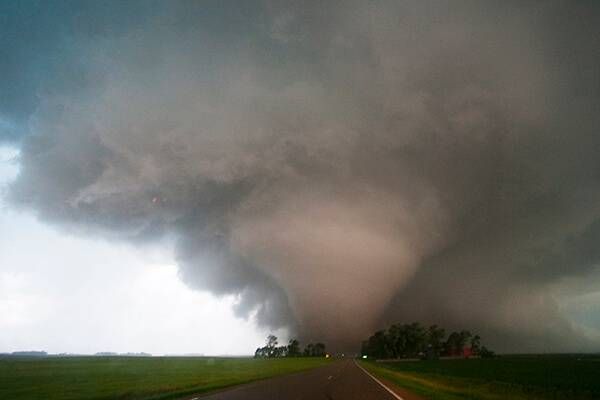
On June 17, 2010 an astonishing 48 tornadoes were reported in and around Wadena and Albert Lea, at least three of which were classified as EF4 cyclones with speeds between 166 and 200 mph.
To take photos or not to take photos…
Before I moved to Minnesota, I lived in both Denver, CO and Rochester, MN, and would frequently drive between the two places. Coincidentally, if you leave Denver in the early morning, you make it to Omaha just in front of the brewing afternoon storms. You can stay in front of them to Des Moines, IA, but it's when you have to turn north on I-35 that you have to be cautious.
One day I ended up with storms coming toward me from the west and knew one in particular was concerning… I quickly tried to find a local radio station as the skies turned that eerie yellow. Before I could tune in a station, I saw people pulled over about a mile ahead, right at the Minnesota-Iowa border, pointing and gawking. As soon as I passed an area clear of trees, I could see it. I remember it looking just like in the movies - a huge, spinning mass, throwing up pieces of corrugated roofing and everything in its path. Even though I had my professional camera and telephoto lens on the seat next to me, just for this occasion, I was too freaked out to stop, and the telephoto lens was a bad choice anyways. I needed wide angle. And I knew I had to get to the I-90 exit to head east in front of the storm so I wasn't in its path. I made it, and as soon as I arrived at an exit that I felt safe to stop at, I pulled over to take some photos. At that point, the large tornado was gone and had been replaced by twin tornados that looked like they were dancing. It was beautiful, but then I felt silly because I had raced so far ahead, the photos barely show them.
Back on my journey, I called my dad to tell him I had just outrun a tornado. "Cool! Where? How big?" was his response. Coincidentally, my mom interrupted our conversation by calling, and when I told her the same, I was greeted with a long, silent pause and a scolding. I bet you can guess which parent I take after. I learned later that the first tornado I saw had been a half mile wide and only five miles away from the point I saw it. Next time, I'll stop and get better photos! - Kim Wilson, Website Developer
A barn is the last place you want to be when a tornado strikes.
I was probably 3 or 4 years old maybe. I was just a little guy. It was just a summer day. They didn't have civil defense sirens or anything at the time. We never went in the basement, we just kind of stayed in the living room of the house. We just had a little root cellar. It was just the old rock foundation with the house sitting on it, so it probably wouldn't have been safe to be in there if the house would have come tumbling down.
My brother, Jim, was holding me when the tornado blew the windows out of the house because of the change in pressure. My mom tried to grab her curtains because she had just put new curtains up and they were getting sucked out of the house.
My brother, Jay, was in the barn when that storm come in, and he remembered that dad said, "Don't stay in the barn if it looks like it's gonna storm." So he ran out of the barn - otherwise he would have been in there when it tipped over. It trapped a bunch of cows, but it didn't kill any of them.
My dad was out at his electrician job. I don't remember where he was, but they somehow got ahold of him, and he came home shortly after. He had no idea that the tornado had even gone through here. This wasn't a mile-wide tornado - it was 100 yards wide, maybe. It took some shingles off the neighbor's barn and tipped ours over, and that was it.
As they rebuilt the barn, there were chickens that were trapped under the barn that were still alive when they got the barn back up. They had to shovel all the loose hay out of the haymow and jack it up and put it back up on the foundation. That's why it's 8 feet shorter than it used to be. - Tim Roelofs, father of Jessie Roelofs, Social Media Specialist
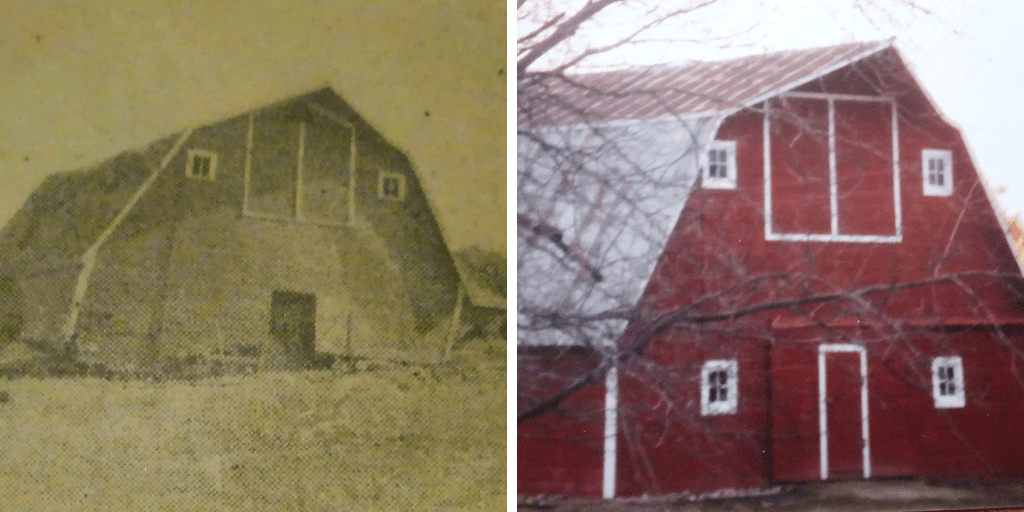
"It's a twister!" - Dorothy
A tornado hit a local farm destroying the home of one of my classmates on the night before graduation. He and his family made it to the graduation ceremony the following day. Our AP English teacher did the faculty commencement address. She apologized, and then began her prepared speech – which was, ironically, based on the Wizard of Oz.
Kinda funny in hindsight. - Adam Lacock, Finance Director
A very close call
I don't have photos, but once, while driving to a video shoot, I saw a lot of leaves and grass fragments "levitate" around me, as if gravity suddenly turned off. I stopped the car and looked up out of the window, knowing there was bad weather coming in, and I saw an unmistakable tornado cone forming above me. It looked just like the movies – a gray/blue tube of cloud. It was 'sideways' or horizontal, to my eyes, and it started to pivot down, almost like those robotic arms you see on assembly lines. Before I could decide what ditch to jump into, it broke apart and was gone, and I've long considered that a very close call. - David Gillette, Anchor/Reporter
"Sharknado is real."
Technically a waterspout. Nowhere near Minnesota.
I stepped out of a bar near the Mina in Tyre, south Lebanon, and saw this. No one seemed panicked. It was out at sea and dissipated before reaching the shore. Not even sure I got wet. Apparently these can deposit fish inland, so, I mean, Sharknado is real. - Steve Spencer, Producer
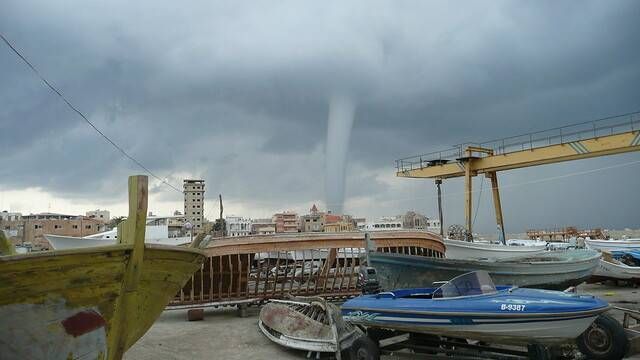

"Sounded like a freight train..."
I live in a condo that overlooks the confluence of the Mississippi and the Minnesota rivers. It was the architect's only residence; he specialized in warehouses, factories and industrial buildings. The result was that are the walls, ceilings and floors in the place are 6-8" of cement; you could fire off a howitzer and your neighbors wouldn't know.
It must have been eight or nine years ago; I woke up in the middle of the night to find it was literally raining sideways due to a ferocious wind. I closed our bedroom window and moved to the balcony. By then, the wind was even stronger and louder, and as I closed the sliding doors, I remember thinking it sounded like a freight train.
When I woke up the next morning to see branches and whole trees down across the river in Crosby Farm Park, I remembered that the freight train analogy was often cited by people who had made it through tornados passing close by. I went online and, sure enough, there had been a touchdown in either West Saint Paul or Inver Grove Heights; I can't remember which, but it was about a mile from us.
Hanging pictures in our building requires a hammer-drill, and putting in new light fixtures means running conduit, and that's OK with me... - Skip Davis, Editor
Nature's Path of Destruction
June 13, 1968
Eleven days short of my 16th birthday, I was at a convention with my parents in Okoboji, Iowa. We had reservations for Vern and Coila's, a popular supper and dance club. Driving there, we spotted several funnels tailing downward from an ominous black wall of clouds. Sirens and the radio were blaring warnings to take cover - now!
Inside, staff led us to the basement, then we returned upstairs to daylight thinking it was safe. But as the clouds circled back, we ran for life, this time taking shelter in the meat locker - just in time. We heard the tornado charge loudly overhead, blasting forward like a roaring railroad train.
Ascending to the restaurant, the roof and second story were totally demolished. Outside, everything was wet, calm, and eerily quiet. No one was hurt, but there was tremendous destruction to Arnolds Amusement Park and many buildings, farms and crops for miles. My husband didn't believe me until I showed him written accounts and photos. I always go to our basement when the sirens sound since I know what can happen in nature's path of total destruction. - Melinda Hoke, Vice President, Philanthropy
